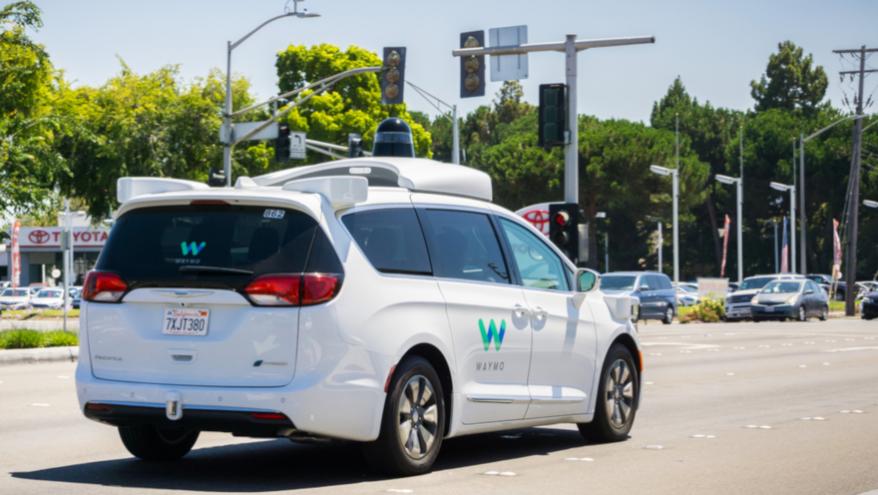Part II: Safety drives autonomous car fears, excitement

A self-driving vehicle from Waymo in California from 2017. Editorial credit: Sundry Photography / Shutterstock.com
If the news in auto industry this week is any indication, safety is the biggest hot-button issue in the autonomous vehicle segment — and could be for a while.
According to a survey from CarGurus released Wednesday, safety is the main cause of concern about self-driving vehicles. But interestingly enough, safety — or perhaps the prospect for greater safety through autonomous vehicles — was also the No. 1 driver of excitement about self-driving cars, the survey found.
Asked for top reasons why they are concerned about autonomous cars, 81 percent of consumers leery about self-driving cars pointed to safety, according to the CarGurus study, which was conducted in April. Meanwhile, 47 percent don’t believe the tech is ready. Third on the list was concern over determining fault (45 percent).
But when drivers who are excited about autonomous vehicles were asked why, 64 percent listed safety as a reason, according to CarGurus. Next on the list was prospects of a productive commute/travel (58 percent). Meanwhile, 54 percent were excited that the vehicle would drive for them.
Safety, it seems, is a double-edged sword in vehicle autonomy.
These survey findings follow two fatal accidents in March connected to autonomous or semi-autonomous vehicles, the first involving a pilot test model of an Uber autonomous vehicle and the second involving a Tesla Model X with semi-autonomous Autopilot, according to an analysis from Autolist.
On Wednesday, the Center for Auto Safety and Consumer Watchdog called for a Federal Trade Commission investigation of Tesla’s Autopilot feature, alleging the automaker was deceptive about that feature’s safety and capabilities.
In an emailed statement, a Tesla spokesperson said: “The feedback that we get from our customers shows that they have a very clear understanding of what Autopilot is, how to properly use it, and what features it consists of.”
Also on Wednesday, news surfaced that Uber would ending its self-driving activities in Arizona, where a pedestrian was killed in the aforementioned March 18 crash involving an Uber test vehicle. The National Transportation Safety Board released its preliminary findings on the incident Thursday.
That winddown in Arizona was confirmed by a company spokesperson, who also said Uber would be ramping up in its engineering hubs of Pittsburgh, San Francisco and Toronto.
“We’re committed to self-driving technology, and we look forward to returning to public roads in the near future. In the meantime, we remain focused on our top-to-bottom safety review, having brought on former NTSB Chair Christopher Hart to advise us on our overall safety culture,” the Uber spokesperson said in an emailed statement.
Regarding the NTSB preliminary findings, the Uber spokesperson said in a statement: “Over the course of the last two months, we’ve worked closely with the NTSB. As their investigation continues, we’ve initiated our own safety review of our self-driving vehicles program.
“We’ve also brought on former NTSB Chair Christopher Hart to advise us on our overall safety culture, and we look forward to sharing more on the changes we’ll make in the coming weeks,” the spokesperson said.
A safety-related change in autonomous vehicles was implored by Washington Auto Show president John O’Donnell during a speech last month at the China-U.S. Automotive Summit in Beijing.
In a recap provided via news release, O’Donnell called for the development of an advocacy group — proposing the name “Global Autonomous Vehicle Engineering Organization,” or GAVEO — to usher in international engineering standards for makers of autonomous cars.
The creation of such an organization and standards is needed immediately to ensure the safe and quick rollout of self-driving technology, he said.
“The time for GAVEO is now, while the autonomous industry is still in its relative infancy,” O'Donnell said at the conference.
“Standardization will make vehicles safer and greatly benefit the consumers who will eventually buy, own and operate self-driving vehicles, while creating stability for automakers, technology companies, and government leaders around the world,” he said.
He proposes a board of engineers with representatives from countries like China, Germany, India, Japan, South Korea, the U.K. and the U.S., where major OEMs have headquarters.
Stateside, researchers at MIT’s Computer Science and Artificial Intelligence Laboratory are looking to tackle one specific challenge that could have safety implications for autonomous vehicles: the process of changing lanes.
The researchers have developed a new lane-change algorithm for self-driving vehicles that they say “splits the difference” between what is a common issue in autonomy: lane-changing algorithms that either lean on statistical models that are too cumbersome to build and then analyze instantaneously or are oversimplified to the point of being “impractically conservative” and perhaps not even changing lanes.
In the MIT news release, the university explains that the algorithm is designed for the vehicle to change lanes more aggressively than it would under a simpler algorithm, without being overcomplicated.
It utilizes just the “immediate information” about the direction and velocity of other vehicles, rather than the complicated model described above. The algorithm is designed to determine what the “buffer zones” are around a self-driving car, with the capability of recalculating in real time.
The researchers were slated to present their findings this past Wednesday at the International Conference on Robotics and Automation.
“The motivation is, ‘What can we do with as little information as possible?’” the first author on the paper and CSAIL postdoc Alyssa Pierson said in a news release.
“How can we have an autonomous vehicle behave as a human driver might behave? What is the minimum amount of information the car needs to elicit that human-like behavior?” Pierson said.
Daniela Rus, the Viterbi Professor of Electrical Engineering and Computer Science and the director of CSAIL, was among those joining Pierson on the paper. She said: “The optimization solution will ensure navigation with lane changes that can model an entire range of driving styles, from conservative to aggressive, with safety guarantees.“

 View The Latest Edition
View The Latest Edition

